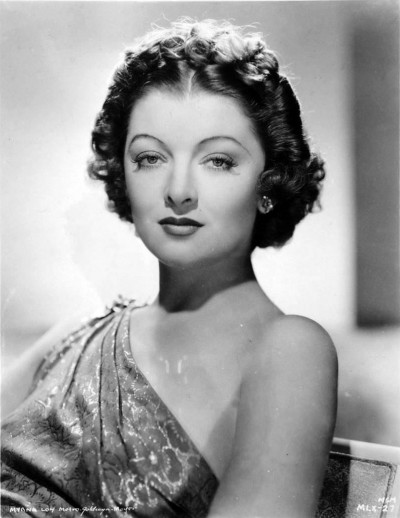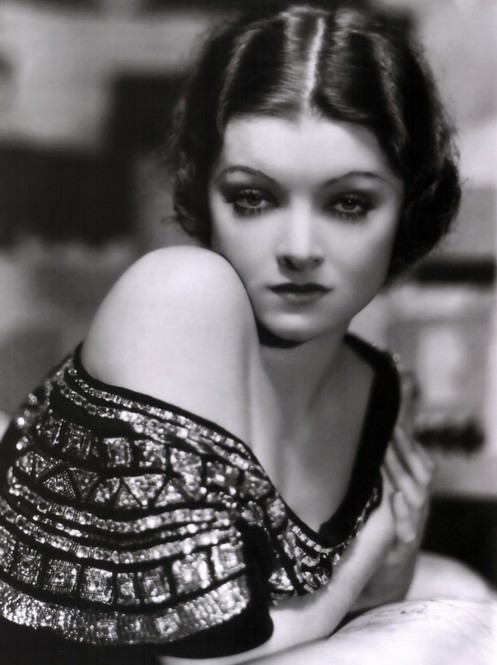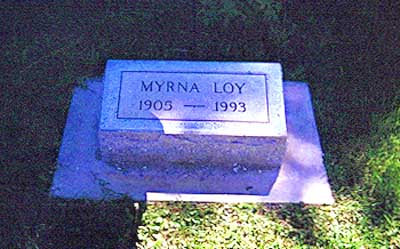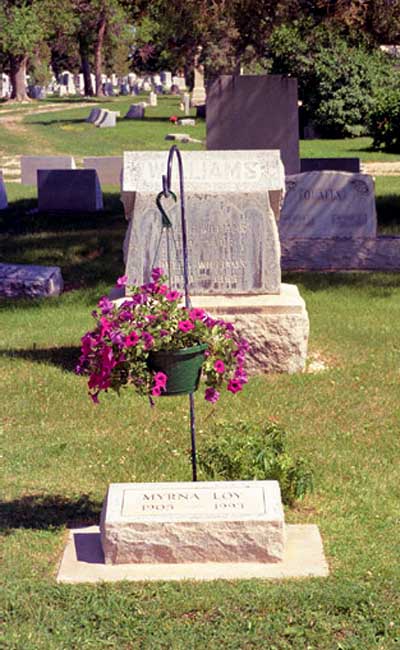Myrna Loy (Myrna Adele Williams)

Loy was born Myrna Adele Williams in Helena, Montana, to Adelle Mae (née Johnson) and rancher David Franklin Williams, and raised in nearby Radersburg. Her paternal grandparents were natives of Wales, and her maternal grandparents were Swedish and Scottish. Her first name was derived from a whistle stop near Broken Bow, Nebraska, whose name her father liked. Her father was also a banker and real estate developer and the youngest man ever elected to the Montana state legislature. Her mother studied music at the American Conservatory of Music in Chicago. During the winter of 1912, Loy’s mother nearly died from pneumonia, and her father sent his wife and daughter to La Jolla, California. Loy’s mother saw great potential in Southern California, and during one of her husband’s visits she encouraged him to purchase real estate there. Among the properties he bought was land he later sold at a considerable profit to Charlie Chaplin so the filmmaker could construct his studio there. Although Loy’s mother tried to persuade her husband to move to California permanently, he preferred ranch life and the three eventually returned to Montana. Soon afterward, Loy’s mother needed a hysterectomy and insisted Los Angeles was a safer place to have it done, so she, Loy, and Loy’s brother David moved to Ocean Park, where Loy began to take dancing lessons. After the family returned to Montana, Loy continued her dancing lessons, and at the age of 12, Myrna Williams made her stage debut performing a dance she had choreographed based on The Blue Bird from the Rose Dream Operetta at Helena’s Marlow Theater.
Loy’s father died on November 7, 1918, of Spanish influenza, and Loy’s mother was finally able to realize her dream to permanently relocate her family to California, where they settled in Culver City. Loy attended the exclusive Westlake School for Girls in Holmby Hills and continued to study dance in Downtown Los Angeles. When her teachers objected to her participating in theatrical arts, her mother enrolled her in Venice High School, and at 15, she began appearing in local stage productions.
In 1921, Loy posed for Venice High School sculpture teacher Harry Fielding Winebrenner for the central figure “Inspiration” in his allegorical sculpture group Fountain of Education. Completed in 1922, the sculpture group was erected in front of the campus outdoor pool in May 1923 where it stood for decades. Loy’s slender figure with her uplifted face and one arm extending skyward presented a “vision of purity, grace, youthful vigor, and aspiration” that was singled out in a Los Angeles Times story that included a photo of the “Inspiration” figure along with the model’s name—the first time her name appeared in a newspaper. A few months later, Loy’s “Inspiration” figure was temporarily removed from the sculpture group and transported aboard the battleship Nevada for a Memorial Day pageant in which “Miss Myrna Williams” participated. Fountain of Education can be seen in the opening scenes of the 1978 film Grease. After decades of exposure to the elements and vandalism, the original cement statue was removed from display in 2002, and replaced in 2010 by a bronze duplicate paid for through an alumni-led fundraising campaign. Loy left school at the age of 18 to help with the family’s finances. She obtained work at Grauman’s Egyptian Theatre, where she performed in elaborate musical sequences that were related to and served as prologues for the feature film. During this period she saw Eleonora Duse in the play Thy Will Be Done, and the simple acting techniques she employed made such an impact on Loy that she tried to emulate them throughout her career.
Portrait photographer Henry Waxman had taken several pictures of Loy, and they were noticed by Rudolph Valentino when the actor went to Waxman’s studio for a sitting. He was looking for a leading lady for Cobra, the first independent project he and his wife Natacha Rambova were producing. She tested for the role, which went to Gertrude Olmstead instead, but soon after she was hired as an extra for Pretty Ladies (1925), in which she and fellow newcomer Joan Crawford were among a bevy of chorus girls dangling from an elaborate chandelier. Rambova recommended Loy for a small but showy role opposite Nita Naldi in What Price Beauty? (1925) Although the film remained unreleased for three years, stills of Loy in her exotic makeup and costume appeared in a fan magazine and led to a contract with Warner Bros., where her surname was changed to Loy.
Loy’s silent film roles were mainly those of vamps or femme fatales, and she frequently portrayed characters of Asian or Eurasian background in films such as Across the Pacific (1926), A Girl in Every Port (1928), The Crimson City (1928), The Black Watch (1929), and The Desert Song (1929), which she later recalled “kind of solidified my exotic non-American image.” It took years for her to overcome this stereotype, and as late as 1932 she was cast as a villainous Eurasian in Thirteen Women (1932). She also played a sadistic Chinese princess in The Mask of Fu Manchu (1932), opposite Boris Karloff. Prior to that, she appeared in small roles in The Jazz Singer and a number of early lavish Technicolor musicals, including The Show of Shows, The Bride of the Regiment, and Under a Texas Moon. As a result, she became associated with musical roles, and when they began to lose favor with the public, her career went into a slump. In 1934, Loy appeared in Manhattan Melodrama with Clark Gable and William Powell. When gangster John Dillinger was shot to death after leaving a screening of the film at the Biograph Theater in Chicago, the film received widespread publicity, with some newspapers reporting that Loy had been Dillinger’s favorite actress.
After appearing with Ramón Novarro in The Barbarian (1933), Loy was cast as Nora Charles in the 1934 film The Thin Man. Director W. S. Van Dyke chose Loy after he detected a wit and sense of humor that her previous films had not revealed. At a Hollywood party, he pushed her into a swimming pool to test her reaction, and felt that her aplomb in handling the situation was exactly what he envisioned for Nora. Louis B. Mayer at first refused to allow Loy to play the part because he felt she was a dramatic actress, but Van Dyke insisted. Mayer finally relented on the condition that filming be completed within three weeks, as Loy was committed to start filming Stamboul Quest. The Thin Man became one of the year’s biggest hits, and was nominated for the Academy Award for Best Film. Loy received excellent reviews and was acclaimed for her comedic skills. She and her costar William Powell proved to be a popular screen couple and appeared in 14 films together, one of the most prolific pairings in Hollywood history. Loy later referred to The Thin Man as the film “that finally made me… after more than 80 films”.
Her successes in Manhattan Melodrama and The Thin Man marked a turning point in her career and she was cast in more important pictures. Such films as Wife vs. Secretary (1936) with Clark Gable and Jean Harlow, and Petticoat Fever (1936) with Robert Montgomery gave her opportunity to develop comedic skills. She made four films in close succession with William Powell: Libeled Lady (1936), which also starred Jean Harlow and Spencer Tracy, The Great Ziegfeld (1936), in which she played Billie Burke opposite Powell’s Florenz Ziegfeld, the second Thin Man film, After the Thin Man with Powell and James Stewart, and the romantic comedy Double Wedding (1937). She also made three more films with Clark Gable. Parnell (1937) was a historical drama and one of the most poorly received film of either Loy’s or Gable’s careers, but their other pairings in Test Pilot and Too Hot to Handle (both 1938) were successes. During this period, Loy was one of Hollywood’s busiest and highest paid actresses, and in 1937 and 1938 she was listed in the annual “Quigley Poll of the Top Ten Money Making Stars”, which was compiled from the votes of movie exhibitors throughout the United States for the stars that had generated the most revenue in their theaters over the previous year.
By this time Loy was highly regarded for her performances in romantic comedies and she was anxious to demonstrate her dramatic ability, and was cast in the lead female role in The Rains Came (1939) opposite Tyrone Power. She filmed Third Finger, Left Hand (1940) with Melvyn Douglas and appeared in I Love You Again (1940), Love Crazy (1941), and Shadow of the Thin Man (1941), all with William Powell. With the outbreak of World War II, Loy all but abandoned her acting career to focus on the war effort and work closely with the Red Cross. She was so fiercely outspoken against Adolf Hitler that her name appeared on his blacklist. She helped run a Naval Auxiliary Canteen and toured frequently to raise funds. She returned to films with The Thin Man Goes Home (1945). In 1946 she played the wife of returning serviceman Fredric March in The Best Years of Our Lives (1946). In later years, she considered this her proudest acting achievement. Throughout her career, she championed the rights of black actors and characters to be depicted with dignity on film. Loy was paired with Cary Grant in David O. Selznick’s comedy film The Bachelor and the Bobby-Soxer (1947). The film co-starred a teenaged Shirley Temple. Following its success she appeared again with Grant in Mr. Blandings Builds His Dream House (1948), and with Clifton Webb in Cheaper by the Dozen (1950).
After 1950, Loy’s film career continued sporadically. In 1952 she starred in the Cheaper by the Dozen sequel, Belles on Their Toes. In 1956 She appeared in “The Ambassador’s Daughter” along with John Forsythe and Olivia de Haviland. She played opposite Montgomery Clift and Robert Ryan in Lonelyhearts (1958), Dore Schary’s adaptation of Nathanael West’s classic 1933 novel Miss Lonelyhearts. In 1960, she appeared in Midnight Lace and From the Terrace, but was not in another film until 1969 in The April Fools. In 1965 Loy won the Sarah Siddons Award for her work in Chicago theatre. In 1974, she was a supporting actress in Airport 1975. Loy played Mrs. Devane, a heavy drinking woman, imbibing in Jim Beam & Olympia Beer mixed together. She played a foil to Sid Caesar. Alongside the film starred fellow silent film star Gloria Swanson. In 1978, she appeared in the film The End as the mother of the main character played by Burt Reynolds. Her last motion picture performance was 1980 in Sidney Lumet’s Just Tell Me What You Want. She also returned to the stage, making her Broadway debut in a short-lived 1973 revival of Clare Boothe Luce’s The Women. In 1981, she appeared in the television drama Summer Solstice which was Henry Fonda’s last performance. Her last acting role was a guest spot on the sitcom Love, Sidney, in 1982.
Myrna Loy died on December 14, 1993, in New York City at age 88. She was cremated in New York. The ashes were interred at Forestvale Cemetery in Helena, Montana. For her contribution to the film industry, Myrna Loy has a star on the Hollywood Walk of Fame at 6685 Hollywood Boulevard. A building at Sony Pictures Studios, formerly MGM Studios, in Culver City is named in her honor. A cast of her handprint and her signature are in the sidewalk in front of Theater 80, on St. Mark’s Place in New York City. In 1991, the Myrna Loy Center for the Performing and Media Arts opened in downtown Helena, Montana, the capital of Montana, not far from Loy’s hometown. Located in the historic Lewis and Clark County Jail, it sponsors live performances and alternative films for under-served audiences.
Born
- August, 02, 1905
- USA
- Helena, Montana
Died
- December, 14, 1993
- USA
- New York, New York
Cause of Death
- surgical complications
Cemetery
- Forestvale Cemetery
- Helena, Montana
- USA




